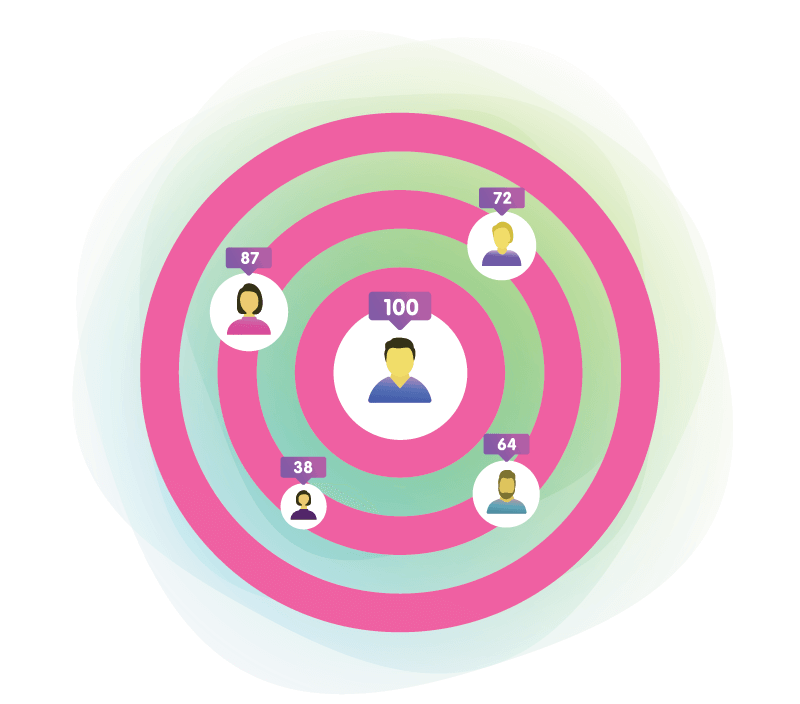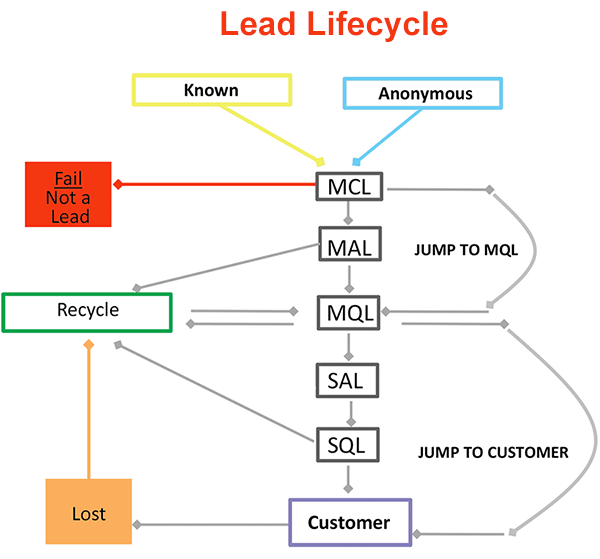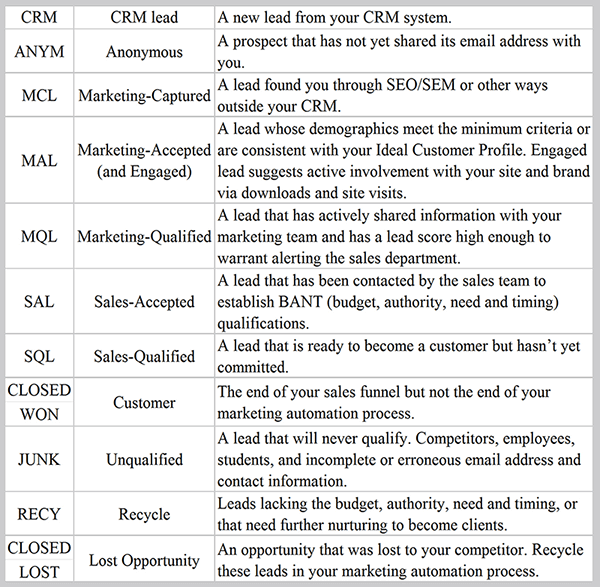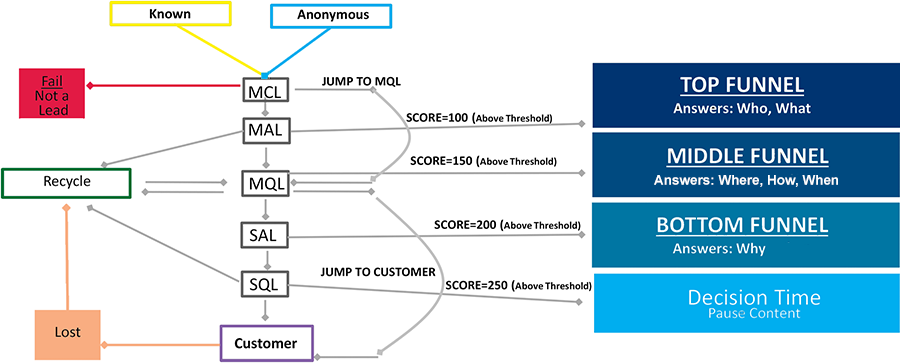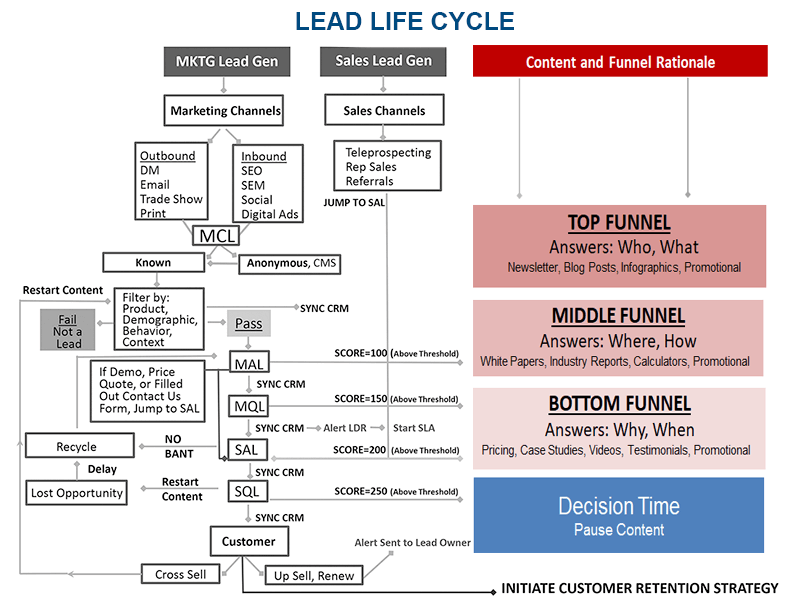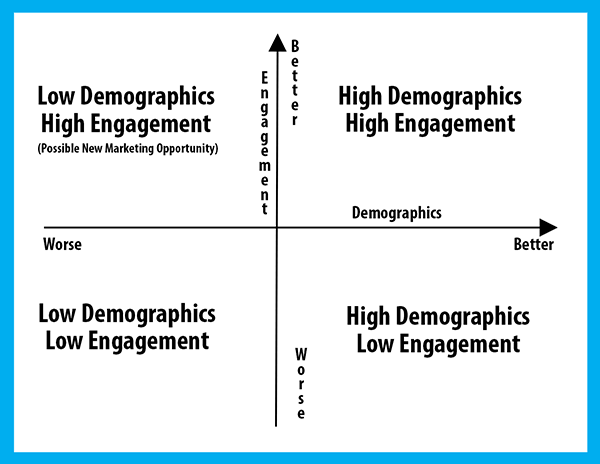The fundamental question is, how do you know when someone is ready to purchase? If you don’t know where your leads are in their buyer’s journey, you can’t meet their needs precisely. A competitor will find a way if you fail to meet their needs. Lead scoring takes the data captured and appended to your MARKETING AI® and frames it in terms of where each prospect is along the buying journey. With this contextualized view of your customers and their behavior, you learn who needs more information, what kind of information is correlated with a prospect’s lifecycle stage, and how best to deliver it. You’ll also make your sales department more efficient and effective because when a prospect reaches the sales-ready lead-score threshold, your marketing team hands off only fully nurtured sales-qualified leads.
It’s helpful to break scoring into three sections: demographic, behavioral, and contextual scores. Demographic scores, as their name suggests, include all the demographic and firmographic information you’ve amassed. These scores are derived from knowing who your audience is. Behavioral and contextual scoring is more fluid. Buyers’ needs change, and these changes appear in their behavior as they interact with you. With your marketing AI and a marketing team that knows how to harness its power, you’re able to encode markers that track behavior across all your content, putting your leads’ actions, interests, and decisions in context so the system can more accurately assess where they are in their buying journey.
Lead scoring is cumulative as a lead’s score rises to a given threshold, and that lead rolls over to the next phase of the Lead Life Cycle. This cumulative score comes from all three lead-scoring elements (demographic, behavioral, and contextual), so a rise in one can trigger movement along the sales pipeline even if the others remain level. For example, a lead that starts with markedly high demographic scores might be close to or above the marketing accepted lead threshold even before factoring in behavioral and contextual scores, indicating this lead is a close match to the firm’s ICP.
Let’s look at SEO Schematics as our example once again. The company has gathered enough data to create a cumulative lead-scoring framework that prioritizes leads in small companies within the advertising sector. Its best customers include business owners, CMOs and CIOs, so people with these job titles earn higher lead scores in the system. This demographic lead score is relatively stable over time.
The company’s new MARKETING AI® has also pinpointed some interesting contextual trends. Leads that have viewed a pricing page on their website or downloaded case studies tend to be closer to a buying decision than visitors who viewed this information, and these leads, therefore, have a higher contextual score. Visitors who sign up for a webinar are highly correlated with sales, but those who follow through by attending send even stronger buying signals; these leads have higher contextual scores even as their demographic scores remain steady.
Lead scoring with the help of marketing automation tools gives businesses the power to rank and develop promising prospects. Companies maximize their marketing investments by taking a data-driven, analytical approach to lead scoring and getting their leads sales-ready.
Establishing a Predeployment Baseline
When meteorologists model what weather systems might do, they use mountains of data from past events and compile probabilities based on the information they already have. Marketing AI systems use similar techniques to score leads and categorize them according to their potential value. Just as weather forecasts have gotten more accurate with the advent of satellite data and software that can analyze it, the science of lead scoring has progressed as technology and marketing automation software have improved.
A powerful, well-maintained CRM system is the most important factor in establishing a baseline for lead scoring. A CRM system can work in tandem with marketing automation systems or be a part of them, but a complete marketing automation system is more complex than a CRM system alone. A MARKETING AI® is an artificial intelligence that cross-references, forms connections, and learns. While CRM has tremendous value for history and tracking, marketing automation software has far greater predictive power. A marketing AI allows businesses to invest their time and effort precisely where and how they’re most effective, and nowhere is that more important than with lead scoring.
Your CRM system’s data is the foundation of a sound lead-ranking strategy. Because you know the outcome of past leads, this data represents an important test case for your lead-scoring system. Feeding data about your past and current customers into the system lets you identify the areas in which these CRM profiles align so your lead scoring system can prioritize them. You get more accurate results by calibrating your marketing automation system using data you already have. In classic spy thrillers, the team synchronizes watches so that every stage of its complex strategy unfolds according to plan. That’s a bit like what calibrating your system using known data does for you. By modeling your lead-ranking strategy with information you already have, you test its veracity — one of the Vs of big data we discussed in Chapter 4. Lead scoring is a dynamic part of a marketing plan, not a static element. Over time, the contextual characteristics that define top leads can change. Competition, audience shifts, business growth, and industry changes impact how leads are valued, too, so marketing automation software that handles lead ranking must also be sensitive to external factors. Regular assessments allow companies to change with market shifts and to separate minor fluctuations from meaningful trends. The test and find out (TAFO) principle applies to developing your lead-scoring standards, and only a marketing AI can keep up with the dynamics of changing customer needs, industry-wide events, and innovations.
Chapter 4 also taught you about the lead types defined by most marketing automation systems. We will be talking more about them here, so let’s look at the Lead Life Cycle and the Lead Life Cycle Model, terms that define where your leads are in the sales pipeline.
Note how many of the buyer’s journey stages rely on placing behavioral data in context. Your marketing-captured lead (MCL), for example, might evolve into marketing-qualified lead (MQL) status by going from visiting your site to signing up for your newsletter, a behavioral change that your marketing AI can put into context as an important step toward sales-readiness.
These terms will familiarize you with the Lead Life Cycle diagram you first saw in the prologue. In the Lead Lifecycle Model below, the lead types are filled in:
See how the CRM syncs with the MAI at every step? That’s part of the interdependence and vital stream of information that makes your MARKETING AI LEAD LIFE CYCLE fully responsive to contextual cues so it can perform as needed.
The MARKETING AI LEAD LIFE CYCLE Rationale
Initially, your prospects just become aware that they may have a problem. This realization may be prompted by a promotional email or through SEO and social links they click as they search for answers to perceived problems with their company’s operations, growth, sales, or marketing. These are the top-of-funnel leads, still anonymously searching through your website and in return for gated content. Since there’s not enough behavioral information about them, your AI’s scoring at this level is based on their demographic profile. They’re researching the “who” and “what” information they need to fix their problem. Serving prospects’ needs at this stage includes an appetizer of simple, bite-size content in blog posts, infographics, and newsletters.
Once these prospects confirm they have a problem, the next step is the Marketing Accepted Lead stage, where they learn “where,” “when” and “how” they can find a solution. Here, the proper response from your marketing AI is to serve them white papers, industry reports, and ROI calculators that help them discover possible solutions. This middle of-funnel content should answer questions like “Where within my company/process, etc., can your product help me?”; “When do I start to see results?”; and “How does this work?”
As your prospects reach the Marketing Qualified Lead stage and just before leads are ready to be handed over to sales, your bottom-of-funnel content should promote the “why” of your message — why should they choose you in particular? Here, your pricing structure, case studies, video, and written testimonials should be sent to establish your value indelibly, and promotions aimed at differentiating you as the industry leader are essential at this point.
Knowing when to send content is important, but knowing when to stop’s just as vital. Your marketing AI pauses the content stream when sales-accepted leads become sales-qualified leads, because, at that point, any additional content could confuse and delay buyers’ decisions to take the last few steps of that long journey. Potential customers don’t need to know more details; they have already made a choice and need marketing messages to step out of the way while the sale happens. A MARKETING AI® controls this delicate but critical shift from marketing to sales and back to marketing.
Live Deployment of Lead-Scoring Strategies
After calibrating your lead-scoring system and defining your leads’ taxonomy, your MARKETING AI®is ready to receive new data with which it can monitor engagement, can assess buying readiness, and can deliver both cumulative and contextual rankings to help your marketing team prioritize its efforts.
The BANT model uses four elements to determine readiness to buy. Only when these four key factors are favorable do promising leads become customers, but taking too long to assess BANT readiness gives competitors an opportunity to contact and develop your lead. Marketing automation and lead scoring are designed to use demographic scoring and behavioral activity to serve content that will reduce the time and distance between initial contact and lead development. Software tools that help establish a prospect’s budget, pinpoint the person with buying authority, locate needs, and monitor a lead’s timeline throughout the sales process have modernized the BANT concept, bringing it into the 21st century. BANT plays a direct role in lead scoring, but it also indirectly underlies many other measurable characteristics. Job titles, for example, correlate closely with buying authority and affect a lead’s score, but recent and frequent clicks on your content demonstrate a high level of need and proper timing.
Lead-scoring systems use both intrinsic characteristics and behaviors to map and rank prospects. Data from an existing CRM system can provide much of the raw material for initial lead scoring, but important information can also come from surveys, preference pages, or data enhancement through append services. A marketing automation system that tracks every aspect of a lead across multiple marketing channels is a must for behavioral data.
The following sections detail some of the primary sources of information that lead-ranking systems use to generate their scores.
Demographic and Firmographic Lead Scoring Elements — Explicit Ranking Data
Some facts, such as the information in the list below, speak volumes about a lead’s likelihood of further development. Demographic and firmographic information tells a lead-scoring system how closely a lead fits the company’s ICP. This explicit data is the foundation on which a lead ranking strategy rests, and ensuring that the information here is accurate is vital. Marketing automation systems can update this data regularly.
- Job title
- Role (function)
- Budget
- Purchasing authority (decision-maker, researcher, part of a team?)
- Honors and awards
- Certifications and degrees
- Years of experience
- Preferred email platform
- Company size
- Company revenue
- Social network participation
- Professional group affiliations
- Location, including city, state and ZIP
- Lead source
Behavior-Based Lead Scoring Elements — Implicit Ranking Data
How leads behave is highly correlated with their level of need and timing. That’s why your MARKETING AI needs to keep a separate, cumulative-behavioral score.
Marketing automation software tracks how a lead interacts with your website design, social- media presence, emails, and other online marketing channels via anonymous browser cookies and JavaScript applets to build a clear picture of where that lead is in the sales cycle. This implicit data is highly predictive of how leads will behave in the future. Look closely at successful results, the interactions, and behaviors prospects took along the way to becoming customers, and you’ll see that certain content is highly correlated with conversions. Some of these behaviors include downloading white papers, visiting pricing pages, and attendance at webinars. Understanding past behavior and knowing what potential customers need to become buyers allows your AI to act on the cues these leads provide. Context determines content.
Think of online behavior as digital body language marketers can use to determine what leads need to develop. In a face-to-face conversation, you can readily gauge your audience’s interest and judge whether it wants to hear more or is just being polite. How do you know? You read subtle cues without even consciously knowing it. Your marketing AI gives you the power to gauge interest and adapt even when your conversation takes place simultaneously with millions of prospects in a global context. Marketing automation places behavioral cues in context for you, and by contextualizing that information, you can communicate naturally with every one of your leads.
Below are some contextual cues for gauging where leads are in the marketing pipeline and ranking their sales-readiness. As implicit information helps your MAI assess interest, monitoring and scoring is essential.
- Requests for samples or free trials
- Newsletter subscriptions
- Pricing Pages
- Hand raise (contact us) forms
- Past buying habits
- Attendance of live-streamed events
- Information downloads
- Email open rates
- Click-to-open ratios
- Seminar or webinar attendance
- Frequency of site visits
- Recency of site visits
- Responsiveness to telemarketing campaigns
- Length of phone calls
- Frequency and recency of content viewing
- Forum and blog participation
- Social referrals, retweets, likes, etc.
Contextual scoring is based on the lead’s category of interest. Most companies sell multiple products, and understanding which product your lead is most interested in is critical to your ability to maximize relevance in your messaging. Your lead will tell you everything you need to know, but if you aren’t observing and cataloging their behaviors, you will probably miss your golden opportunity to close the deal.
Negative Results as Lead Ranking Elements
Sometimes prospects say more about what they don’t do than what they do. To go back to the body language analogy, these signals would be equivalent to a stifled yawn or a look around the room from a conversation partner. Lead-scoring systems can assign negative numbers, in some cases, to move these leads down the list of priorities. Lead scoring should also build in a natural decay-scoring strategy for leads that no longer interact with you over a given period.
Some examples include:
- Joining a do-not-call list
- Long periods of website inactivity (lost opportunity, changed jobs)
- High bounce rates
- Unsubscribe requests from email and newsletters
- Deleting email messages unread
- Spam complaints
- Lack of response to telemarketing or email
- Negative comments on social media or blog posts
Sample Lead Scoring Results
Quantifying leads according to their explicit data fit and implicit engagement looks different from system to system, but generally, lead-ranking software can generate a detailed report on how every lead’s score is calculated. Your pre-deployment baseline sets the criteria for evaluation, but with most lead-scoring software, each element should be further adjusted (individually) for fine-tuning.
The following example represents what MAS lead-scoring software may generate for SEO Schematics.
| Elicit Data: | Scores | Reasons for Scores |
|---|---|---|
| Company president | +15 | High authority equals high lead value |
| Advertising-related SIC code | +10 | Many of SEO Schematics’ customers are in advertising |
| Ideal customer profile | +20 | Extra points for meeting title, industry, and size ICPs |
| MS in computer engineering | + 7 | Technical knowledge aligns well with current CRM base |
| 50+ employees | + 5 | Company size is a good fit for target market |
| Active on social media | + 5 | Social media activity correlates closely with sales |
| Location 100–200 miles | + 2 | A closer business would have a higher score here |
| Behavioral Data: | ||
| Webinar download | +20 | Participants have historically been close to buying |
| Newsletter subscription | +15 | Newsletter readers are highly engaged |
| Visited pricing page | +10 | A visit to the pricing page indicates high interest |
| Time on site >5 minutes | + 7 | More time at the site implies more engagement |
| No response to telemarketing | – 5 | This lead’s interest doesn’t extend to phone calls |
| Total score: | 91 | |
This lead is a close fit with the company’s customer profile and has evinced a high level of interest; it’s sales-ready and needs very little incentive to go from prospect to customer. The lowest marks relate to the company’s distance from the seller and the negative response to telemarketing.
Knowing these details, the marketing team can then come up with strategies to lessen the potential impact of distance on this sale (offering 24/7 customer assistance via phone or website, for example) and to contact this customer by means other than his office phone. Automated lead scoring also categorizes leads into priority levels. The example above would be an A-list priority due to the high overall score and few negatives. The A group might include any lead score above 60; the B group could range from 30 to 60, and the C-list includes those from 0 to 30. Leads scores should never be set below zero, because you want to give a lead that’s built up significant negative behavior the ability to score positively if it presents a real opportunity in the future. But you should consider adding a recycling phase or reducing its score to zero, particularly if that lead had chosen to opt-out of available marketing channels.
Postdeployment Lead-Ranking Analysis and Optimization
An automated lead-scoring system can crunch huge numbers, but its results appear in an easily read format. A graph of lead scores indicates the next steps your marketing team should take to capitalize on each lead’s unique characteristics. While scoring systems are customizable and can translate results into multiple formats, graphs along an X-Y axis are becoming the industry standard. If the X-axis represents demographic fit and the Y-axis indicates behavior, leads naturally fall into four quadrants.
- Those with a good demographic fit and high engagement scores are at the upper right of the graph and are your highest priority. They are on the verge of buying and can often go directly to the sales team to close.
- Leads with a good fit but low engagement appear at the bottom right of the graph and represent long-term investments. Although they may not be customers yet, they have a good likelihood of becoming buyers in the future with the right marketing messages over time.
- The data points in the upper left quadrant of your graph represent the outsiders, leads with high engagement scores but don’t look like your current customers demographically. These leads can either be your competitors, employees and students, or these leads can indicate an untapped new market that deserves further study. Your marketing team should contact these leads and learn more about them to find out more about their interest.
- At the lower left are leads with low engagement and an unlikely fit. Their lead scores are the lowest and indicate that they are the lowest priority for your marketing department. As with all leads, they may change over time, but they should not be the focus of a major marketing campaign.
Lead scoring is a moving target. As leads take new actions, their profiles and scores can change, so your marketing automation tools must keep pace with these changes by regularly updating files. Data updates may be automatic, but you can take additional steps to maximize the power and precision of lead ranking through analysis and review.
Look at your results over time to pinpoint wins and losses. If high-scoring leads fail to result in sales, it’s vital to understand why. These cases are often the most instructive, so scrutinize them carefully to see if they represent cases of poorly qualified leads finding their way through the system or well-qualified ones that the conversion process failed before the promising lead reached the sales department. Is there a way to account for similar cases in the future by adjusting the information measured or sensitivity of your lead scoring system?
Demographic and firmographic data is probably a part of your CRM system already, but the rich vein of information about behavior is something an automated marketing system is particularly good at mining. A thorough nurture campaign is the essential ingredient that supports sales by maximizing the profitability of every lead. A lead without scoring is an unknown; if neither your marketing department nor your sales team can provide accurate information on the lead, it will remain unqualified.
A mismanaged or siloed scoring system that fails to take demographic, behavioral, and contextual information into account will likewise not produce good results. Even if you have a lead-scoring system that tells you where a lead is now if the system is unable to track prospects over time and assign them to nurture tracks that make sense for them you can’t become part of the solution. Without the right nurturing campaign to send the right content at the right time, you’re wasting your efforts and your leads’ time.
Look at behavioral data over time to fine-tune lead scoring and develop a more accurate picture of prospects as they interact with you. It’s tempting for creative to take an idea and run with it during the execution phase, pushing it out of the nest and watching it fly, but without a blueprint in place and the necessary strategy to hold the concept aloft, your marketing AI cannot execute a successful campaign. No matter how artful a creative effort is it can only succeed if it reaches the right audience with the right message at the right time through their preferred marketing channels. In next week’s issue, you’ll learn how to coordinate content across multiple channels and guide your prospects to where they need to go to turn cold to warm prospects and opportunities into satisfied customers.
Next Blog: MA Series – Chapter 6: Initial Communication, Retargeting, and Triggers
A MARKETING AI® Mindmap
In this series Marketing AI®: From Automation to Revenue Performance Marketing, you’ll learn much more about what marketing automation is, what it isn’t, and where it fits into a marketing strategy. You’ll also discover more about traditional marketing through the lens of automation and read a compelling case study about how one company went from finding itself in a marketing dead zone to flourishing as an automated, intelligent, and responsive organization that converted its old marketing plan into a revenue marketing strategy.
Sign Up To Receive Future Enewsletters
Copyright 2021 Reach Marketing LLC
MARKETING AI® is a registered trademark of Reach Marketing, LLC

